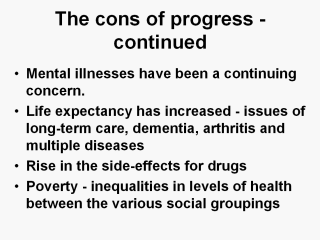| front |1 |2 |3 |4 |5 |6 |7 |8 |9 |10 |11 |12 |13 |14 |15 |16 |17 |18 |19 |20 |21 |22 |23 |24 |25 |26 |27 |review |
 |
Throughout the period
covered by this work, mental illnesses have been a continuing concern.
Whereas in the early years most of the mentally ill were cared for in
institutions, often isolated deep in the countryside; few of these asylums
still exist, and most patients are looked after in the community. But the
trend may now be changing back to some extent. Along with the reduction of infections, life expectancy has increased with a rapidly growing population at the upper end of the age spectrum. This has coincided with increased population mobility, and the weakening of family bonds. Issues of long-term care, dementia, arthritis and multiple diseases have to be considered alongside other priorities for health care. Violence, whether towards children, partners or in the streets, has been present over the years and there is little evidence of any profound change in incidence or effective means of prevention other than reducing alcohol consumption, a difficult step to achieve. With the increase in the availability and use of effective drugs, there has also been a rise in the side-effects they can cause. From the public health point of view, they have underlined the need for an adequate system of surveillance. Poverty stands out as a factor of major impact on health throughout the whole period. There has been an indisputable improvement in standards of life in state provision for those in need. The change from the old Poor Law to the present welfare and benefits system has improved life for many. But even with these changes, inequalities in levels of health between the various social groupings have remained to the detriment of the deprived and are unacceptable at the end of the 20 century. |